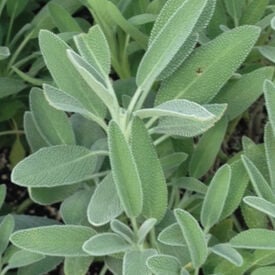Learn More
Broadleaf sage, also known as Salvia officinalis, is a robust perennial herb prized for its large, aromatic leaves and culinary versatility. Characterized by its broad, velvety gray-green leaves, this variety has a more pronounced flavor than some other sages, offering a warm, earthy taste with hints of mint and citrus. Native to the Mediterranean region, broadleaf sage is often used in cooking to enhance dishes such as meats, poultry, and stuffing, as well as in herbal teas. The plant thrives in well-drained soil and full sun, making it a favorite in herb gardens. Broadleaf sage is also valued for its medicinal properties, traditionally used for digestive health and inflammation. With its striking foliage and delightful aroma, this sage variety is both an attractive addition to gardens and a staple in kitchens.
White sage, scientifically known as Salvia apiana, is a revered perennial herb native to the southwestern United States and northwestern Mexico. Characterized by its silvery-gray leaves and aromatic, slender stems, white sage is highly valued for its fragrant, cleansing properties. Traditionally used by Indigenous peoples for spiritual practices, such as smudging, it is believed to purify spaces and promote healing. The leaves have a strong, earthy aroma when dried, making them popular for incense and herbal teas. White sage thrives in well-drained, sandy soil and full sun, and it’s often grown in gardens not only for its cultural significance but also for its striking appearance and drought-resistant qualities. With its deep-rooted historical and cultural importance, white sage continues to be cherished for both its beauty and its aromatic properties.


